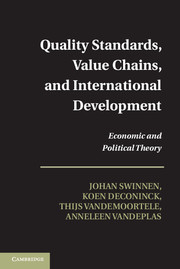Book contents
- Frontmatter
- Contents
- Preface and Acknowledgments
- 1 Introduction
- 2 Modeling Standards
- 3 Efficiency and Equity Effects of Standards
- 4 The Political Economy of Standards and Development
- 5 International Trade and Standards
- 6 Risk, Externalities, and the Nature of Standards
- 7 Endogenous Private and Public Standards in Value Chains
- 8 Butterflies and Political Economy Dynamics in Standard Setting
- 9 The Political Economy of Standards and Inclusion in Value Chains
- 10 Standards, Production Structure, and Inclusion in Value Chains
- 11 Standards, Market Imperfections, and Vertical Coordination in Value Chains
- 12 Market Power and Vertical Coordination in Value Chains
- 13 Price Transmission in Value Chains
- 14 Commodity Characteristics and Value Chain Governance
- 15 Economic Liberalization, Value Chains, and Development
- 16 Standards and Value Chains with Contracting Costs: Toward a General Model
- 17 General Equilibrium Effects of Standards in Value Chains
- References
- Index
17 - General Equilibrium Effects of Standards in Value Chains
Published online by Cambridge University Press: 05 August 2015
- Frontmatter
- Contents
- Preface and Acknowledgments
- 1 Introduction
- 2 Modeling Standards
- 3 Efficiency and Equity Effects of Standards
- 4 The Political Economy of Standards and Development
- 5 International Trade and Standards
- 6 Risk, Externalities, and the Nature of Standards
- 7 Endogenous Private and Public Standards in Value Chains
- 8 Butterflies and Political Economy Dynamics in Standard Setting
- 9 The Political Economy of Standards and Inclusion in Value Chains
- 10 Standards, Production Structure, and Inclusion in Value Chains
- 11 Standards, Market Imperfections, and Vertical Coordination in Value Chains
- 12 Market Power and Vertical Coordination in Value Chains
- 13 Price Transmission in Value Chains
- 14 Commodity Characteristics and Value Chain Governance
- 15 Economic Liberalization, Value Chains, and Development
- 16 Standards and Value Chains with Contracting Costs: Toward a General Model
- 17 General Equilibrium Effects of Standards in Value Chains
- References
- Index
Summary
Introduction
In the previous chapters we have analyzed how various factors influence the emergence of value chains and the inclusion of different types of producers in value chains (Chapter 10) and the distribution of surplus within these value chains (Chapters 11, 12, and 16). This focus reflects the general assumption in the vast majority of studies that any benefits to smallholders from the rise of high-standards value chains could only come through their role as supplier. However, some recent studies show that, even when poor households are excluded as suppliers because of high standards, they may still benefit importantly through the labor market, that is from employment by larger firms (Maertens and Swinnen, 2009; Maertens et al., 2011). The only studies that try to measure income and poverty effects of large-scale employment find strong poverty reducing effects through labor markets for poor households involved as workers producing high-standards exports in Africa.
More generally, much of the literature (whether theoretical or empirical) has focused on partial effects. What is lacking in the debate around high-standards value chains is a consistent and comprehensive conceptual framework for capturing the multitude of effects and interpreting the partial effects observed in empirical findings. As noted, few studies include labor market effects. In addition, no studies analyze general equilibrium effects such as demand and supply spillover effects on other markets, such as staple foods, which may have very important impacts on farm income in developing countries. Measuring these effects econometrically is very difficult because annual datasets usually do not contain the necessary data on high-standards market and datasets from surveys targeted to measure impacts of the growth of high standards typically do not have sufficient information (either spatially or dynamically) to measure spillover effects on other markets. However, as emphasized by Acemoglu (2010), an understanding of general equilibrium effects is necessary because a failure to do so may lead to wrong estimates and incorrect policy conclusions.
This chapter presents a computable general equilibrium (CGE) model to identify the various mechanisms through which the introduction and growth of high standards can influence welfare and poverty. The model has both low-standards and high-standards value chains, and explicitly integrates key characteristics of many developing and emerging economies, such as capital and labor market constraints. This allows us to analyze how and through which channels the welfare of rural and urban households is affected.
- Type
- Chapter
- Information
- Quality Standards, Value Chains, and International DevelopmentEconomic and Political Theory, pp. 269 - 282Publisher: Cambridge University PressPrint publication year: 2015

